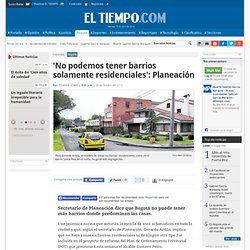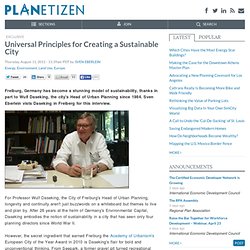

Commentary: When Tokyo Was a Slum. This essay touches on many of the themes that we will be exploring in the Informal City Dialogues: The way cities develop incrementally and at the hands of ordinary citizens, the role of government in planning and infrastructure, and how neighborhoods integrate with the larger urban system.

Through examples like this one, we hope to gain a greater understanding of how to build more inclusive, resilient cities for all. Our future in cities. The Evolution of Urban Planning in 10 Diagrams - Design. Le Corbusier’s plan may not have had such power if he hadn’t put it on paper.

The French modernist architect wanted to reform the polluted industrial city by building “towers in a park” where workers might live high above the streets, surrounded by green space and far from their factories. His idea was radical for the 1930s, and it was his diagrams of it that really captured the imagination. "It swept everyone along," says Benjamin Grant, the public realm and urban design program manager for the San Francisco Planning and Urban Research Association.
Secretario de Planeación habla sobre barrios en Bogotá - Noticias de Bogotá - Colombia. Una polémica norma que autoriza la mezcla de usos urbanísticos en toda la ciudad y que, según el secretario de Planeación, Gerardo Ardila, implica que no haya zonas exclusivas residenciales ni de ningún otro tipo fue incluida en el proyecto de reforma del Plan de Ordenamiento Territorial (POT) que presentará esta semana el alcalde Gustavo Petro.

Shared Space. The concept of building shared space within the public realm is a radical one here in the United States, where automobiles are not only given priority, but completely dominate most public spaces.

With the financial insolvency inherent in our current approach becoming more and more apparent each day, there is a need to study alternatives. The shared space model -- while a dramatic departure from the status quo -- can help us build Strong Towns while making our urban neighborhoods safer in the process. La velocidad de la ciudad del futuro >> I Love Bicis. En el imaginario colectivo, influenciado por las películas de Hollywood, las ciudades del futuro vuelan con tranvías y coches flotantes moviéndose a una velocidad supersónica.

Video - Breaking News Videos from CNN.com. Ciudades superdotadas · ELPAÍS.com. Dicen que la mejor manera de limpiar una casa es no ensuciarla y que la energía más barata es la que no se gasta.

¿Y si el objetivo es mantener limpia una ciudad o rebajar la factura de la luz en una autopista? El futuro es la inteligencia · ELPAÍS.com. Universal Principles for Creating a Sustainable City. For Professor Wulf Daseking, the City of Freiburg's Head of Urban Planning, longevity and continuity aren't just buzzwords on a whiteboard but themes to live and plan by.

After 26 years at the helm of Germany's Environmental Capital, Daseking embodies the notion of sustainability in a city that has seen only four planning directors since World War II. Daseking and his team have also found creative ways to accommodate population growth within its coveted city limits by using available land to build bustling eco-villages: Rieselfeld, a former brownfield area, and Vauban, once a French military base, are ecologically integrated and socially diverse developments that make car-free and high density living easy, fun, and a matter of civic pride for its residents.
On a recent visit to Freiburg, writer and Ecocity Builders contributor Sven Eberlein talked to Professor Daseking about his experiences, visions and the lessons to be learned from the Freiburg experiment by American cities. Global Reports on Human Settlements. Contested Streets. This is your brain in the city « Per Square Mile. For a kid who spent much of his childhood outdoors—alternately splitting time between the wooded park down the street, my friends’ backyards, and a patch of countryside my parent’s tended—I have been spending a lot of time in rather large cities as an adult.

Ever since I left college, I’ve lived in cities that count their residents in hundreds of thousands and metro areas that count in the millions. It’s gotten me to wondering, what effect are these throngs of people having on my brain? An answer to that question scrolled across my Twitter feed last week in the form of a paper published in Nature. Village Towns. The Continued Relevance of Reclaiming the Urban Memory. “What has been is what will be, and what has been done is what will be done; and there is nothing new under the sun.”

Future Cities. James Howard Kunstler. Which-part-detroit-if-any-really-needs-right-sizing from... At the bottom of this post are two short videos about Detroit, both featuring architect and planner Mark Nickita, principal of the city's Archive Design Studio and a lifelong Detroit resident.

In a very refreshing change from the mind-numbing negativity one usually hears about the city, Nickita is upbeat and hopeful. His point of view, emphasizing revitalization, is much closer to my own than much of what I read, which effectively takes the approach that the city has somehow been abandoned beyond redemption, leaving the only question how to manage its more-or-less permanent shrinkage.
Trancón en Bogotá durará más de dos años. Se requiere una política pública centrada en el peatón para solucionar los problemas de movilidad. Por ahora, pico y placa de tres días a la semana podría ayudar. Long commutes cause obesity, neck pain, loneliness, divorce, stress, and insomnia. - By Annie Lowrey. This week, researchers at Umea University in Sweden released a startling finding: Couples in which one partner commutes for longer than 45 minutes are 40 percent likelier to divorce. The Swedes could not say why. Perhaps long-distance commuters tend to be poorer or less educated, both conditions that make divorce more common. Perhaps long transit times exacerbate corrosive marital inequalities, with one partner overburdened by child care and the other overburdened by work.
A Physicist Turns the City Into an Equation. Wiki cities. Sprawl. Smarth Growth.